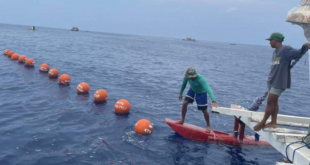Agri Dept., OCD set plans to limit El Niño damage on food production

Photo Credit: da.gov.ph
The government has put in place water management strategies to limit the damage that the El Niño dry spell will have on agricultural production, including collecting and storing rainwater, the Department of Agriculture (DA) said Friday.
The DA said it encourages food producers to stock rainwater for future use, citing that the country sees an average rainfall volume of 2,348 millimeters.
It is also implementing other water management projects, such as the improvement of irrigation canals and other small-scale irrigation projects.
Other mitigation projects include the replacement of unserviceable pumps and engine sets.
The chairman of the DA’s National El Niño Team, U-Nichols Manalo, said they are closely working with operating units under the department to address the possible effects of the weather phenomenon.
“These are just some of the measures that the government has been doing early on to prevent production losses due to the dry spells that El Niño entails,” he said.
Early this week, President Ferdinand R. Marcos Jr. announced that the government would release an El Niño Mitigation Plan to enable the public to take part in national actions to cushion the effects of the weather phenomenon.
Weather experts expect an unusual warming of sea surface temperatures, which may lead to the strengthening of the abnormal weather phenomenon in the coming months.
The likelihood of below-normal rainfall is anticipated, causing dry spells and droughts in some areas of the country.
However, the western part of the country may still get above-normal rainfall due to the enhanced southwest monsoon.
The National Disaster Risk Reduction Council-Office of Civil Defense(NDRRMC-OCD) on Friday said it will convene the National El Niño Teamin Camp Aguinaldo, Quezon City on July 19 as it synchronizes the preparations for the looming drought and dry spell
“We are looking forward to the finalization of the National Action Plan for El Niño by this team as we continue to undertake various activities specific to our agency mandates.” OCD Administrator and Undersecretary Ariel Nepomuceno said in a statement.
Various team clusters are expected to present short-, medium-, and long-term plans to address food security, water security, energy security, health, and public safety issues due to the El Niño effects.
The state weather bureau is expected to provide an updated forecast of the climate phenomenon as well as the status of the various dams in the country.
On July 4, the Philippine Atmospheric, Geophysical and Astronomical Services Administration (PAGASA) declared the start of the El Niño phenomenon in the Tropical Pacific. Its effects, the state weather bureau said, are now expected in the Philippines.
The El Niño phenomenon is characterized by the abnormal warming of sea surface temperature in the central and eastern equatorial Pacific Ocean and below normal rainfall.
Due to the El Niño, PAGASA said that as of June 30, dry spells were already experienced in Apayao, Cagayan, and Kalinga based on the provinces’ three-month actual rainfall.
A dry spell is three consecutive months of 21 percent to 60 percent reduction in the average rainfall or two consecutive months of over 60 percent reduction.
PAGASA said dry conditions were also experienced in Isabela and Tarlac provinces.
Meanwhile, PAGASA said the Angat Dam in Bulacan needs at least four to five tropical cyclones to enable its water elevation to go back to normal.
Richard Orendain of PAGASA’s Hydrometeorology Division said with one tropical cyclone, the dam’s water elevation could only go up to its minimum operating level of 180 meters.
Angat Dam’s normal high water level is 210 meters.
About 65 millimeters of rain poured over the Angat watershed last Thursday.
On Friday morning, the Angat water level increased to 179.09 meters, still below the minimum operating level of 180 meters.
Orendain said there is a lag time of 18 to 24 hours for the rains dumped upstream to reach the reservoir.
He added that another storm after tropical depression Dodong could also increase Angat’s water level.
Roy Badilla, Hydrometeorology Division chief, said the rains due to the southwest monsoon or “hanging habagat” were not sufficient to significantly raise Angat Dam’s water elevation.
The dam supplies 97 percent of Metro Manila’s potable water.
Also on Friday, Senate President Pro Tempore Loren Legarda called on Metro Manila residents to take advantage of the heavy downpour during the afternoon and evening.
“We can innovate many ways to collect rainwater and use that for watering our plants or flushing down our toilets,” she said. “We conserve water consumption as levels in Angat Dam have continued to fall beyond its minimum operating level.”
As a result of the declining levels, Maynilad Water Services, Inc. had announced that a nine-hour water service interruption would affect about 600,000 of its customers.
Maynilad operates in 17 cities and municipalities scattered across the west zone of the Greater Manila Area, servicing at least 9.5 million consumers. — Vince Lopez and Rio N. Araja
*****
Credit belongs to: www.manilastandard.net
 Atin Ito First Filipino Community Newspaper in Ontario
Atin Ito First Filipino Community Newspaper in Ontario






